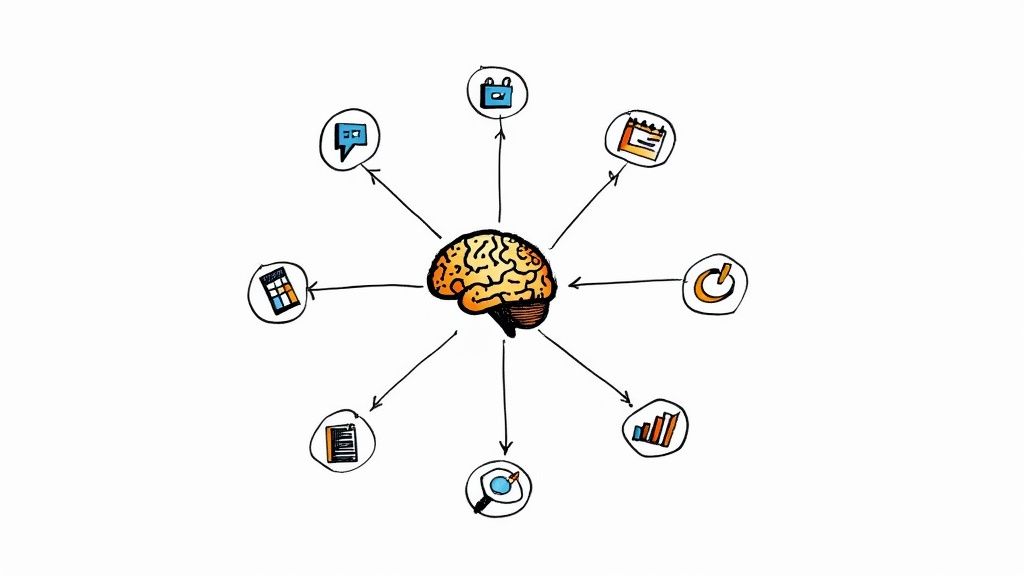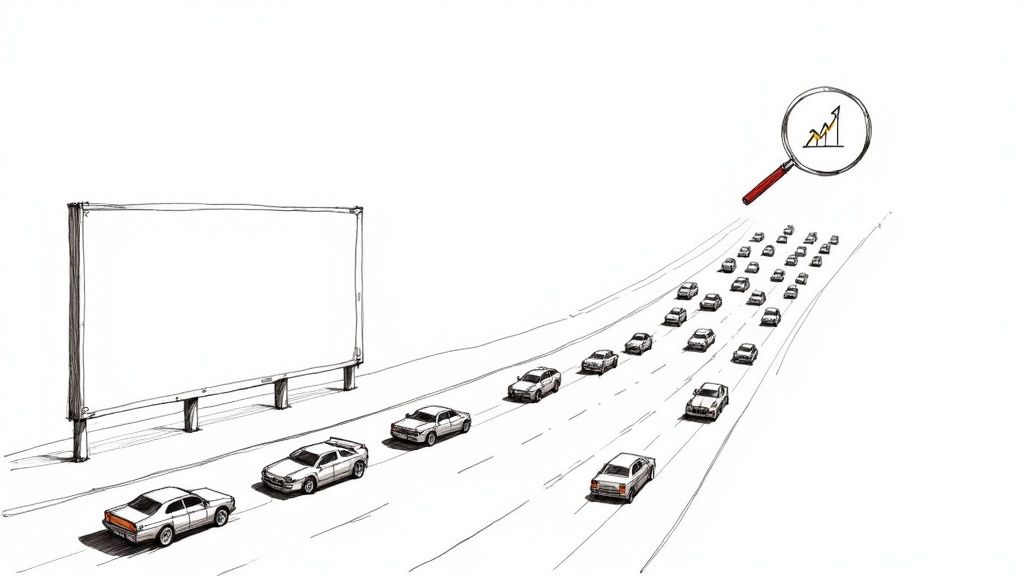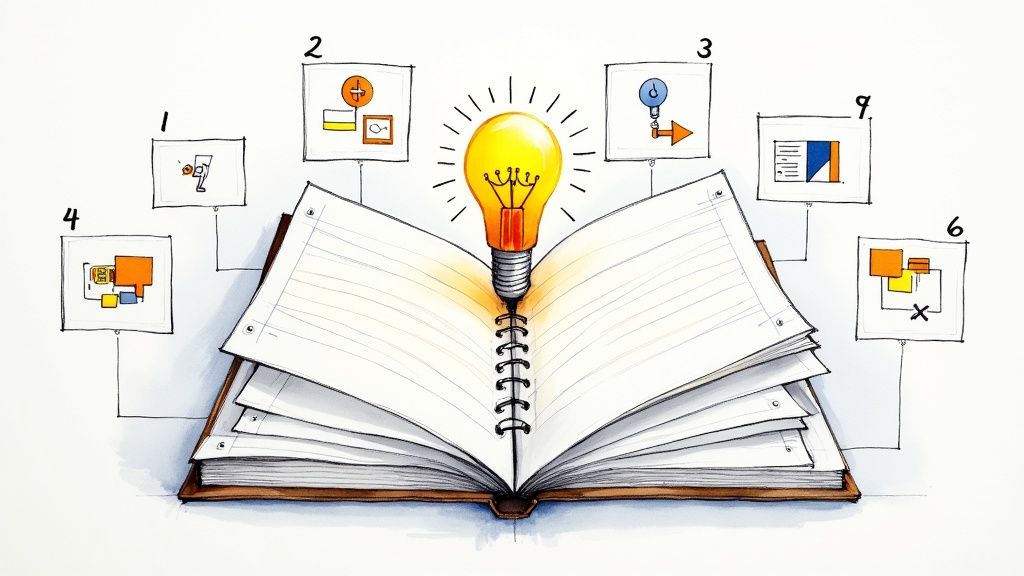
Oct 12, 2025
Ethan Monkhouse
Ever feel like you’re shouting into the void? You craft the perfect post, hit "publish," and... crickets. It’s a frustratingly common story, and the culprit is often not what you post, but when. Finding the best time to post is more than just a minor tweak; it’s a fundamental strategy for getting your content in front of the right people when they're actually online and ready to engage. Generic advice like "post on Tuesdays at 10 AM" only gets you so far.
To truly stop guessing and start growing, developing a data-driven approach to your social media posting schedule that truly works is paramount. This guide moves beyond the one-size-fits-all answers. We're breaking down 8 actionable strategies that combine broad platform insights with the unique data from your specific audience.
You’ll learn how to decode your own analytics using tools like Naviro, leverage platform-specific peak times, and run simple tests to pinpoint your unique content sweet spot. It's time to stop throwing content at the wall and hoping it sticks. Let's dive in and build a posting strategy that delivers the engagement your content deserves.
1. Analyze Your Audience's Active Hours
Forget those generic "best time to post" articles for a second. The single most effective strategy is to figure out when your specific audience is doomscrolling, sharing, and engaging. This foundational step involves diving into your analytics to understand your followers' unique online habits, time zones, and daily routines.
Think of it this way: a B2B SaaS company’s followers are likely most active during the 9-to-5 workday, while a B2C fashion brand’s audience might peak during evenings and weekends. Sprout Social's research backs this up, showing massive variations in peak times across industries. Your own data holds the key to unlocking maximum engagement.
Pinpointing Your Peak Engagement Windows
So, how do you find this data? Most platforms provide it for free.
Instagram Insights: Navigate to the 'Audience' tab to see a breakdown of when your followers were most active over the last week, both by day and by hour.
Facebook Page Insights: The 'Posts' section reveals when your fans are online, giving you a clear picture of peak daily activity.
Naviro Analytics: Our platform synthesizes this data, tracking not just when people are online but when they are most likely to engage with your content, providing a more accurate window for optimal posting.
This bar chart shows a sample of how audience engagement can fluctuate throughout the day, highlighting specific peak times.
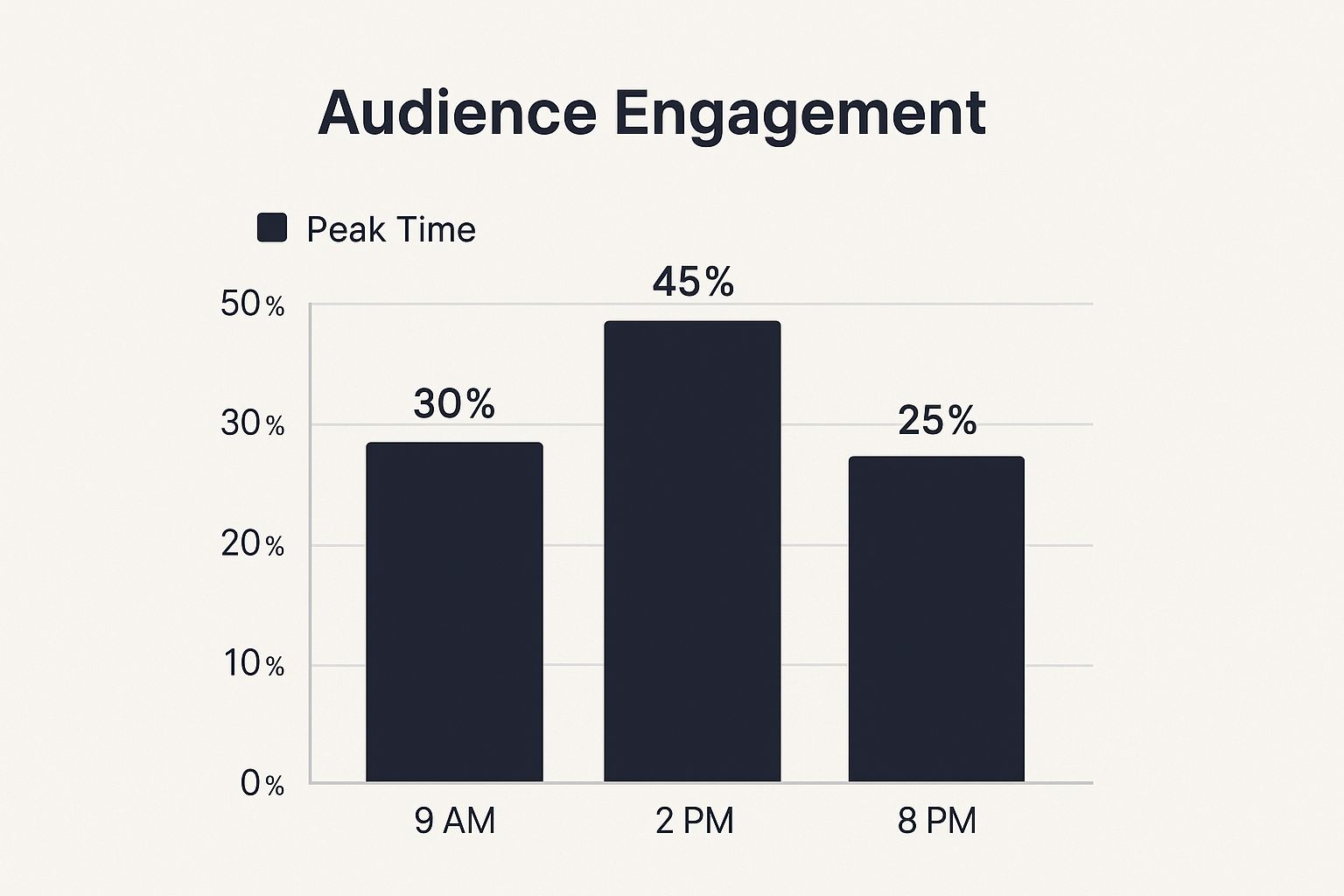
As the chart illustrates, the afternoon at 2 PM is the absolute sweet spot for this specific audience, capturing nearly half of all daily engagement. If you have a global following, you can take this a step further by creating different content schedules. For a deeper dive into this, you can learn more about how audience segmentation can refine your strategy. This data-driven approach ensures your content lands in front of the right people at the right time.
2. Consider Platform-Specific Peak Times
Beyond your specific audience, each social media platform operates like its own unique ecosystem with distinct user behaviors and traffic patterns. The best time to post isn't a one-size-fits-all answer because a user scrolling LinkedIn during their lunch break has a different mindset than someone browsing TikTok before bed. Understanding these platform-specific nuances gives you a powerful starting point for your scheduling strategy.
Think about it: LinkedIn is a professional network, so its users are most active during the traditional workweek. In contrast, platforms like Instagram and TikTok are built for entertainment and leisure, naturally leading to peak engagement during evenings and weekends. Major social media management platforms like Hootsuite and Sprout Social consistently publish research highlighting these differences, providing an excellent baseline before you even look at your own analytics.
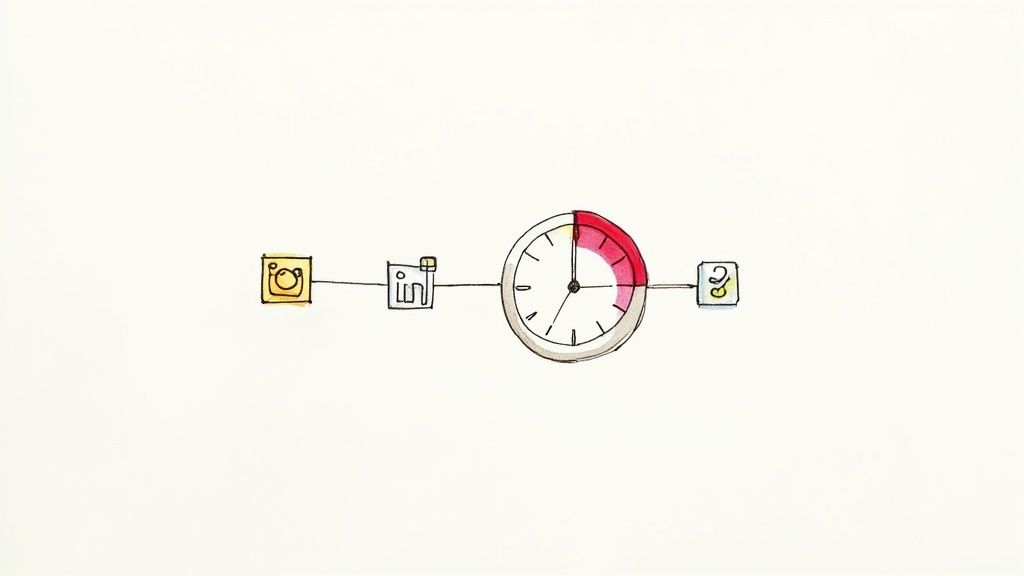
Leveraging Platform Benchmarks
How can you use this general data effectively? Start with industry-wide benchmarks as your initial hypothesis and then test and refine.
LinkedIn: Engagement peaks during the workday. Aim for Tuesday through Thursday, between 9 AM and 12 PM, when professionals are catching up on industry news and networking.
Instagram & Facebook: These platforms see high engagement during lunch breaks and after work. CoSchedule's research points to Wednesday at 11 AM for Instagram, while HubSpot suggests Wednesdays between 1 PM and 2 PM are prime time for Facebook.
TikTok: Usage surges during commutes and late-night scrolls. Sprout Social data indicates high engagement on Tuesday at 9 AM, Thursday at 12 PM, and Friday at 5 AM EST, catching users during key moments of their day.
Using these widely accepted peak times as a foundation allows you to make informed decisions from day one. You can then use Naviro’s platform-specific analytics to see how your audience's behavior aligns with or deviates from these norms, allowing for precise, data-backed adjustments to maximize your reach on every channel.
3. Test and Iterate With A/B Timing Experiments
While analytics give you a fantastic starting point, the most reliable way to pinpoint the best time to post is through controlled experimentation. A/B timing tests involve posting similar content at different times and days to see which slot produces the best engagement. This scientific approach removes all guesswork and reveals the specific patterns of your audience that generic studies and even your own past data might miss.
This method is about active discovery, not passive analysis. For example, fitness influencer Kayla Itsines discovered through testing that her 5-6 AM workout posts vastly outperformed afternoon content. Similarly, e-commerce giant Gymshark A/B tested product launch announcements and found that Tuesday at 3 PM drove 43% more engagement than their previous Friday slot. This shows how a small timing tweak can yield massive results.
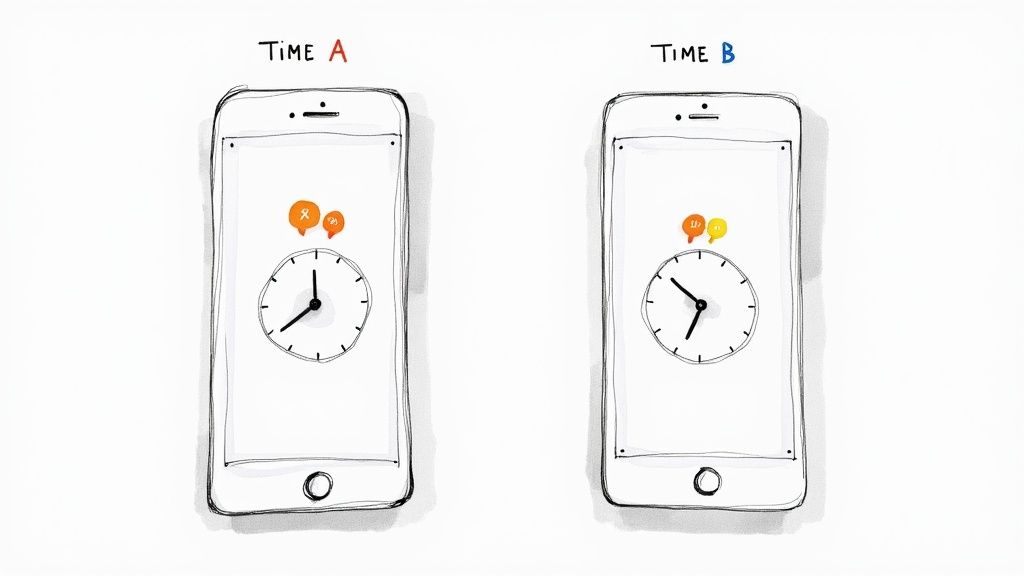
Launching Your Own Timing Tests
Ready to find your brand's unique sweet spot? Here’s how to run a clean and effective A/B timing test.
Isolate One Variable: To get clear results, test only one thing at a time. Post identical or very similar content at two different times (e.g., 9 AM vs. 9 PM) on the same day of the week.
Run It Long Enough: Don't base your strategy on a single post. Run each test for at least 3-4 weeks to gather enough data and account for any anomalies or off-days.
Track Engagement Rate: Don't just look at raw numbers like likes and comments. Calculate the engagement rate percentage (total engagements divided by followers) to account for audience growth during your test.
Use the Right Tools: A reliable scheduling tool is crucial for posting at precise times. Furthermore, you'll need a way to measure the results accurately. You can explore the best Instagram analytics tools to find a platform that simplifies this tracking process.
By systematically testing and documenting your findings, you can build a data-backed posting schedule that is truly optimized for your audience and their habits.
4. Account for Time Zones in Global Audiences
If your brand has gone global, posting based on your local time zone is like throwing a party and only inviting your neighbors. The best time to post for your audience in New York is the middle of the night for your followers in London or Tokyo. Ignoring time zones means a huge chunk of your audience will miss your content entirely, sabotaging your reach before you even hit "publish."
Strategic time zone management is crucial for maximizing global engagement. This means you stop thinking in one timeline and start planning for several. For example, a major news outlet like BBC World doesn't just post during UK business hours; they strategically schedule content to hit peak engagement windows in the Americas, Europe, and Asia, ensuring a constant stream of fresh updates for every follower, no matter where they are.

How to Schedule for a Worldwide Audience
So, how do you put this into practice without staying up 24/7? It's all about identifying key audience hubs and scheduling content accordingly.
Find Your Follower Hubs: Use Instagram or Facebook Insights to see your followers' top locations by city and country. Identify your top three geographic concentrations to start.
Find the Overlap: Look for a time that serves multiple regions well. Posting around 12-2 PM EST often catches the US lunch break, the UK evening wind-down, and the early morning for parts of Asia.
Post in Batches: Don't be afraid to post the same core message multiple times, perhaps with a slight variation. Cristiano Ronaldo's team does this masterfully, ensuring his massive fan bases in Europe, the Americas, and Asia all see his updates during their active hours.
Leverage Scheduling Tools: Our platform, Naviro Analytics, helps you automate this process. You can schedule a single post to go live at the optimal time for each major time zone, removing the guesswork and manual effort.
By treating your audience as a collection of distinct regional groups rather than a single monolith, you ensure your content consistently lands with maximum impact. This thoughtful approach is a non-negotiable step for any brand with global ambitions.
5. Leverage the Algorithm's Favor for Consistent Posting
Beyond finding the perfect single moment, a huge part of winning on social media is being reliable. Social media algorithms, from Instagram to LinkedIn, reward consistency. When you establish a predictable posting schedule, you’re not just feeding the algorithm; you're training your most engaged followers to anticipate your content, creating powerful habit-based engagement.
Think of it like your favorite TV show. You know when it airs, so you tune in. Similarly, creators like Gary Vaynerchuk post multiple times daily at set intervals, training his audience to check back constantly. This reliability signals to the algorithm that you're a committed, high-quality creator, which can lead to your content being prioritized in your followers' feeds. It’s a powerful way to determine the best time to post by making any time your time.
Building a Habit-Forming Schedule
Creating this kind of consistency doesn’t mean you have to burn out. It's about being strategic and sustainable.
Establish a Cadence: Choose a frequency you can realistically maintain. Whether it's three times a week or once a day, stick to it. Post at the same time(s) each day or on the same days each week to build that audience expectation.
Communicate Your Schedule: Don't keep it a secret! Add "New videos every Tuesday at 3 PM!" to your bio or mention it in your content. This turns passive followers into an active audience waiting for your next drop.
Use Scheduling Tools: Life gets busy. Use tools like Naviro to schedule your posts in advance. This ensures your content goes live at the optimal time, even when you’re not online. Batch-creating content on your productive days will keep your calendar full for weeks ahead.
This approach transforms your posting strategy from a reactive task into a proactive system. By building a reliable presence, you create a loyal community that knows exactly when to show up, amplifying your engagement long-term.
6. Monitor Industry and Seasonal Timing Variations
The best time to post isn't a "set it and forget it" metric. Your audience's online behavior is constantly influenced by industry trends, holidays, seasons, and major events. A truly effective posting strategy is fluid, anticipating these cyclical shifts to stay relevant and maximize reach when it matters most.
Think about it: a tax preparation firm will see a huge engagement spike in the evenings leading up to the April filing deadline, while a travel brand’s audience might be most active dreaming of getaways during the dreary winter months. These external factors dramatically alter when people are online and what they’re looking for. Adapting your schedule to these rhythms is crucial for landing your message at the perfect moment.
Adapting Your Calendar to Cyclical Trends
Anticipating these changes requires a mix of historical data analysis and forward-thinking planning. Here’s how to start adapting your strategy.
Retail Brands: During the November-December holiday rush, increase posting frequency and shift to evening and weekend hours when shoppers are browsing.
Fitness & Wellness: Capitalize on the "New Year, New You" motivation by boosting content in early January, especially during morning and post-work hours.
B2B Companies: Be mindful that engagement often dips on Friday afternoons and Monday mornings. Also, track major industry conferences when your audience might be less active on general social media but more active on specific event hashtags.
Naviro Analytics: Our platform allows you to compare engagement data year-over-year, making it easy to spot seasonal patterns and predict future peaks. This helps you build a proactive content calendar that aligns with your audience’s changing priorities.
By looking beyond daily and weekly trends, you can align your content with the broader context of your audience's lives. This foresight ensures your brand remains part of the conversation, whether it’s a holiday shopping spree or a seasonal shift in consumer needs.
7. Prioritize Early-Week Posting for Maximum Engagement
While your unique audience data is king, broad industry trends offer a powerful starting point. Overwhelmingly, research shows that engagement peaks during the middle of the workweek. This pattern holds true across most platforms and industries, making Tuesday, Wednesday, and Thursday your prime real estate for content.
This phenomenon is tied directly to human behavior. Mondays are for catching up after the weekend, and by Friday, focus shifts to wrapping up and logging off. The sweet spot is that mid-week window when people are settled into their routines and are most actively scrolling, sharing, and engaging. For example, HubSpot found that B2B blog traffic is highest on Tuesdays, while Sprout Social's data consistently points to Tuesday through Thursday as the best time to post on professional networks like LinkedIn.
Capitalizing on Mid-Week Momentum
Aligning your content schedule with this natural rhythm can give your most important posts a significant boost.
Schedule High-Impact Content: Save your most important announcements, product launches, or pillar content for Tuesday, Wednesday, or Thursday to maximize reach and interaction.
Use Weekends Strategically: Weekend posting can be a gamble. For B2B brands, it's often a dead zone. However, B2C industries like retail or travel can see success, as that's when people are shopping or planning leisure activities.
Bookend the Week: Use Mondays for lighter, "ease into the week" content. Reserve Fridays for more casual, fun, or community-focused posts as your audience winds down.
This bar chart illustrates a typical engagement curve across the week, showing a clear peak in the middle.
As shown, Wednesday hits the absolute peak, with Tuesday and Thursday close behind. By front-loading your best content early in the week, you align with your audience's natural online behavior. You can use Naviro's scheduler to map out your content calendar and ensure your key posts always land on these high-engagement days.
8. Balance Posting Time with Content Longevity and Algorithm Delays
Posting when your audience is most active is smart, but it's only half the story. Modern algorithms don’t instantly blast your content to every follower. Instead, they test it with a small group first, and if the initial engagement is strong, they’ll push it to a wider audience. This algorithmic delay means the best time to post isn't just about catching your audience online; it's about giving your content enough runway for its distribution cycle to kick in.
Think of it like this: a TikTok video or Instagram Reel can go viral hours or even days after you post it. The algorithm needs time to test, learn, and expand its reach. Similarly, content on search-based platforms like Pinterest and YouTube has a much longer lifespan. A Pinterest pin for "Christmas recipes" will perform best if posted in October, not December, because it needs time to get indexed and discovered by users planning ahead.
Giving Your Content Time to Breathe
So, how do you factor in these algorithmic delays and content longevity? It's about posting ahead of the curve.
Instagram Reels & TikToks: Post 2-4 hours before your audience's peak active time. A post at 8 AM has the entire day for the algorithm to test it and serve it to the larger lunchtime or evening crowds.
YouTube Videos: Publish your video 2-3 hours before your target viewing time. This gives the platform time to process the video and start suggesting it to subscribers and relevant audiences right as they log on.
Pinterest & Long-Tail Content: Plan for the long game. Create and post seasonal content 6-8 weeks in advance to capitalize on search-based discovery. The immediate posting time is less critical than the long-term timing strategy.
The goal is to align your posting schedule with the platform's distribution mechanics, not just user activity. Focus on generating strong initial engagement by responding to comments immediately, as this signals quality to the algorithm and speeds up the distribution process. By giving your content this buffer, you maximize its potential to reach the largest possible audience. You can find more strategies for this in our guide to improving social media engagement. This forward-thinking approach ensures you're working with the algorithm, not against it.
8 Key Factors for Optimal Posting Time
Strategy | 🔄 Implementation Complexity | 💡 Resource Requirements | 📊 Expected Outcomes | 💡 Ideal Use Cases | ⭐ Key Advantages |
|---|---|---|---|---|---|
Analyze Your Audience's Active Hours | Medium - Requires data analysis over time | Uses native analytics tools (free) | Personalized peak engagement insights | Accounts with sufficient follower base | Data-driven, personalized, adapts to audience |
Consider Platform-Specific Peak Times | Low - Based on published benchmarks | Minimal; relies on existing studies | Quick-start guideline for posting times | New accounts or before having own data | Easy to implement, backed by large-scale data |
Test and Iterate With A/B Timing Experiments | High - Requires controlled, consistent testing | High; needs frequent posting & tracking | Concrete, account-specific optimal timing | Accounts ready for scientific optimization | Reveals unique patterns; builds long-term knowledge |
Account for Time Zones in Global Audiences | Medium-High - Complex scheduling decisions | High; may need scheduling tools | Maximized reach across multiple regions | Accounts with global, diverse audience locations | Increases total engagement; shows professionalism |
Leverage the Algorithm's Favor for Consistent Posting | Medium - Requires consistent discipline | Moderate; content planning needed | Improved content visibility and habit formation | Creators aiming for sustained engagement | Builds audience habits; may boost algorithmic priority |
Monitor Industry and Seasonal Timing Variations | Medium - Ongoing monitoring and adjustment | Moderate; requires industry research | Adaptive strategy aligned with real-world changes | Brands needing seasonal or industry-specific tuning | Keeps strategy relevant; capitalizes on peaks |
Prioritize Early-Week Posting for Maximum Engagement | Low - Simple scheduling rule | Low; minimal adjustment needed | Higher engagement early in the week | B2B and professional content creators | Easy to apply; backed by research across platforms |
Balance Posting Time with Content Longevity and Algorithm Delays | High - Sophisticated understanding required | High; deep platform knowledge needed | Optimized distribution beyond immediate reach | Accounts focused on algorithm-driven growth | Accounts for algorithm delays; reduces timing pressure |
Turn Your Timing Insights into Sustainable Growth
We've covered a lot of ground, from analyzing platform-specific peak hours to running your own A/B timing experiments. It's clear that finding the best time to post isn't about uncovering a single "magic hour" but rather building a dynamic, data-informed scheduling strategy that evolves with your audience.
Think of it less like a treasure map with an 'X' marking the spot and more like a weather forecast. Your job is to read the patterns, understand the climate of each platform, and predict when your content has the best chance of shining. The core principle tying everything together is simple: listen to your data.
Your Actionable Roadmap to Smarter Scheduling
Let's distill our key takeaways into a clear, actionable plan you can implement right now:
Start with Benchmarks, End with Your Data: Use the general platform peak times we discussed as your starting line, not your finish line. Your own analytics are the ultimate source of truth.
Embrace Experimentation: Don't be afraid to test unconventional posting times. Schedule posts an hour earlier or later than usual, try a weekend slot you've previously ignored, and meticulously track the results. Consistent, small tests yield massive long-term insights.
Consistency Trumps Perfection: A slightly imperfect but consistent posting schedule is far more effective than a sporadic one that perfectly hits a few peak moments. Algorithms reward reliability, and your audience will come to expect your content.
Content and Timing are Two Sides of the Same Coin: Perfect timing won't save weak content, and amazing content can get lost if posted at the wrong time. To truly turn your timing insights into sustainable growth, it's equally important to consistently produce high-quality, engaging content. If you're looking for inspiration, these 10 Practical Social Media Content Ideas can help you fill your calendar with posts your audience will love.
Ultimately, mastering your posting schedule is about shifting from guesswork to a growth mindset. Every post is a new data point, and every engagement metric is a clue. By combining platform knowledge, audience analysis, and strategic testing, you stop chasing the algorithm and start making it work for you. The goal is to create a predictable system that delivers your valuable content to the right people, at the moment they are most likely to engage.
Ready to stop guessing and start growing? Naviro uses AI to analyze your unique audience data, identify your true optimal posting times, and provide actionable insights to fuel your growth strategy. Take the manual work out of finding the best time to post and let our growth engine do the heavy lifting for you. Try Naviro today and turn your data into your biggest advantage.

